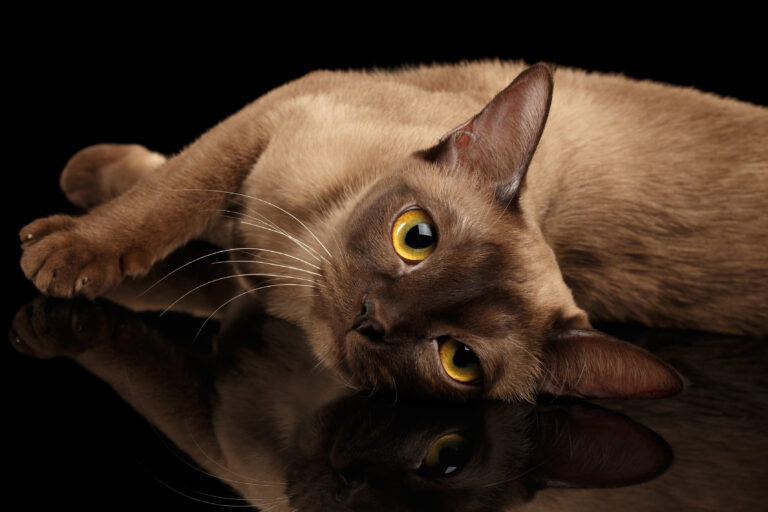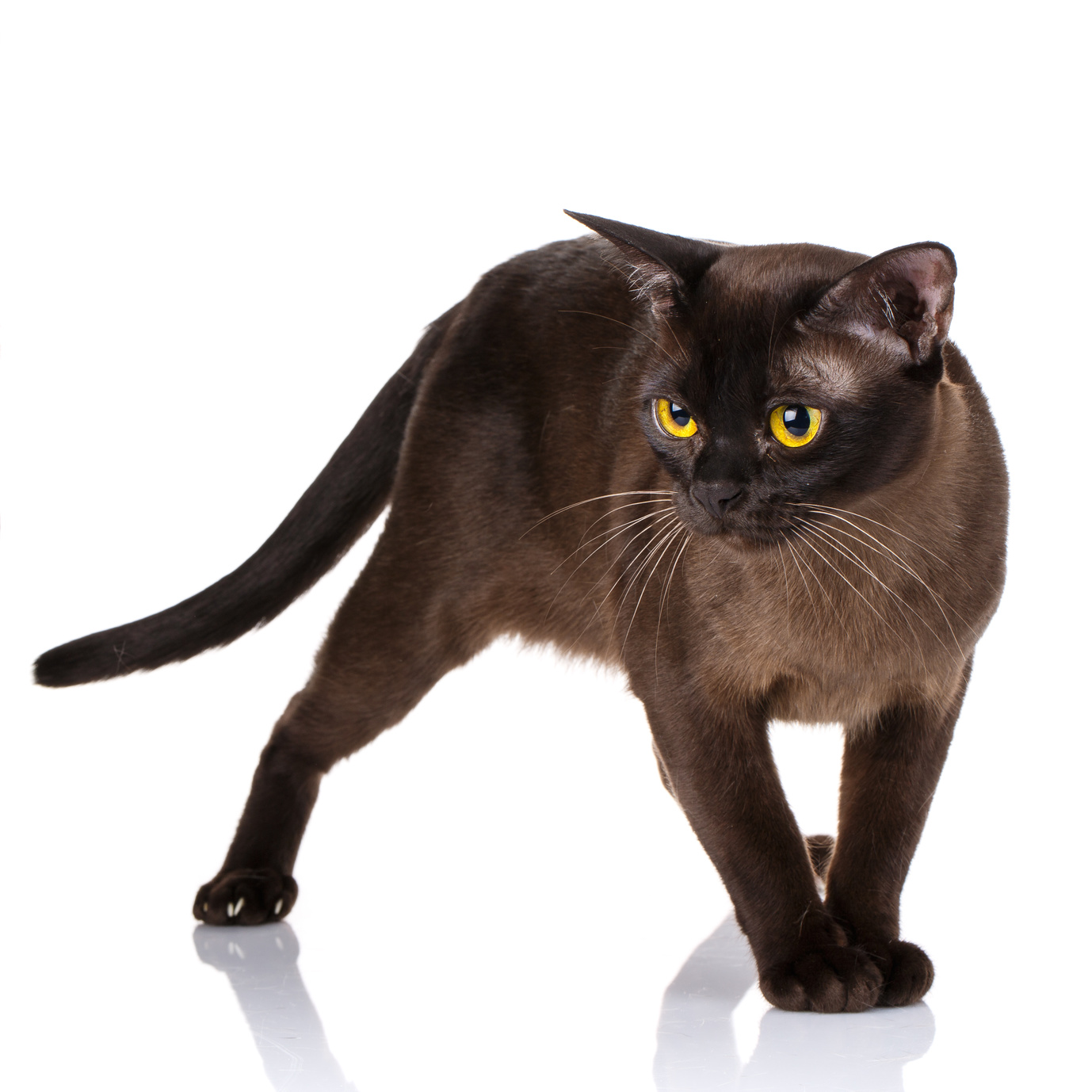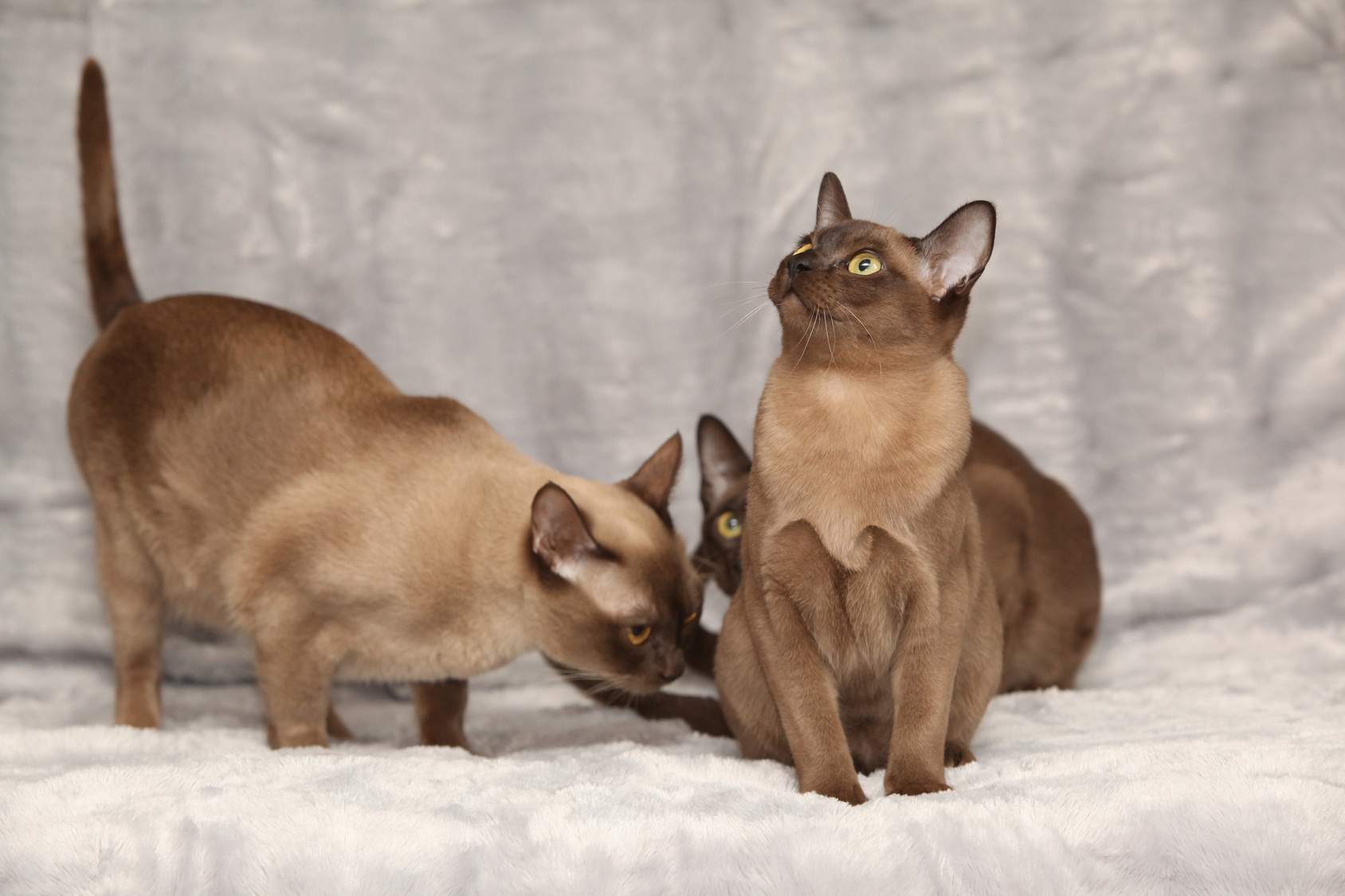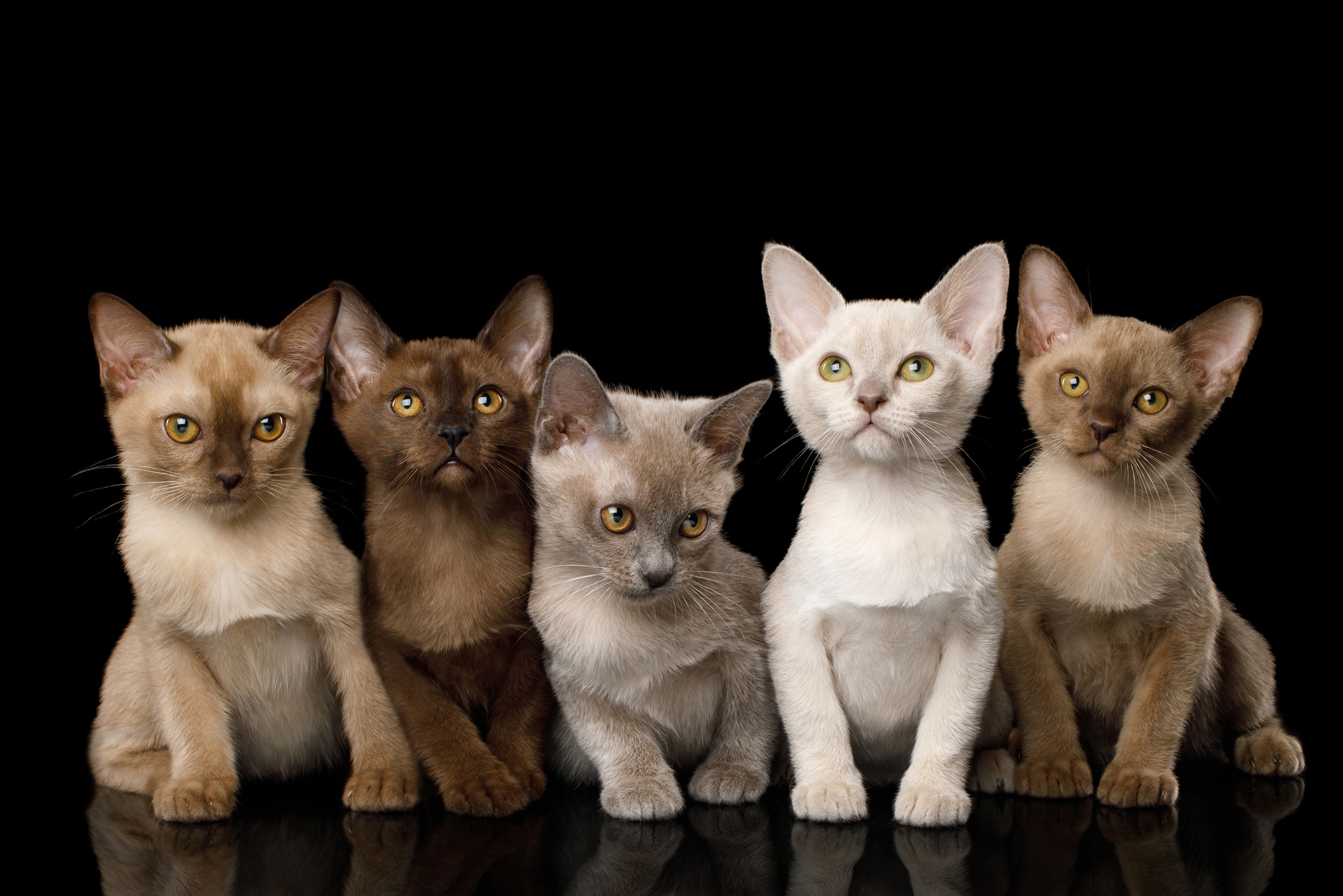Maine Coon
The Maine Coon has now become one of the most popular cat breeds in the world and is enjoying increasing popularity in Ireland, too. This is probably thanks to its authenticity, robustness and excellent character.
The “Good Luck Cat” – this description of the Burmese cat from its original Thai homeland describes the breed perfectly! These chatterboxes love humans and spend their lives playing and frolicking!

© seregraff / stock.adobe.com
The Burmese cat, often known simply as the Burmese, belongs to a group of oriental cat breeds and comes from Myanmar, previously known as Burma. The Burmese should not be confused with the Birman, also originally from Burma but with longer hair and French roots.
The Burmese is one of the few cat breeds with two distinct breeding standards. This is thanks to the great difference between the European Burmese, originally the British Burmese, and the American Burmese. These are also known as “traditional” and “contemporary” respectively. American Burmese cats are much stronger and stockier, with a broad chest and head as well as a shorter muzzle. European Burmese cats are generally leaner and more athletic in build and are primarily popular in Europe, perhaps unsurprisingly.
Burmese cats are usually a small to medium breed, with females weighing up to 4kg and males at around 6kg. These graceful yet muscular creatures are similar to the classic Siamese, although not quite as slimly built as the modern version of the breed. The Burmese is somewhat more compact than its long-legged Siamese relation. It has a wide chest and straight back that is supported by delicate legs and oval-shaped paws. Its face is captivating, thanks to large, wide eyes and ears. These beguiling ears sit either side of a wedge-shaped head featuring a wide, rounded forehead. The large, slightly almond-shaped eyes glow a brilliant amber.
A Burmese cat’s coat is silky and gleaming. It is extremely light and there is just a small amount of undercoat lying close to the skin. This is a characteristic inherited from its ancestors in the warm Southeast Asian climate.
The fur is generally a solid colour without any real pattern, although younger Burmese cats may show light tabby colouring. It is not unusual for a Burmese to have a slightly darker face, something that is fairly sought after. Ten different colour varieties are officially recognised: blue, chocolate, brown and red, as well as others known as the “dilute division”, which include lilac, cream and a range of two-tone variations such as chocolate-tortoiseshell, blue-tortoiseshell, brown-tortoiseshell and lilac-tortoiseshell.
The description of tortoiseshell, often abbreviated to “Tortie”, describes a three-coloured cat with distinctive markings. Due to the genetic characteristics of this colouring, all tortoiseshell three-coloured cats are female. The Burmese can be found in a range of tortoiseshell varieties:
Depending on where the Burmese cats are being bred, there are a number of other colour varieties available. For example, in New Zealand the Burmese often comes in cinnamon, fawn, caramel or apricot, as well as silver varieties. In addition, Burmese cats with tabby colouring are not unheard of.
 © serkucher / stock.adobe.com
© serkucher / stock.adobe.com
Burmese cats are intelligent, inquisitive and lively, as with most oriental cat breeds. These trusting cats love to get involved wholeheartedly with people, enjoying playing and entertaining younger family members. The Burmese remains agile and attentive even in older age and loves nothing better than having a good conversation! However, even being part of a large human family cannot replace a fellow feline companion. Burmese cats dislike being alone, which means they may not make the ideal pet for those hoping for just a single-cat household.
These cats are enthusiastic about moving around and keeping active, enjoying being kept both physically and mentally busy. Being kept indoors all day is not the ideal living situation for a Burmese cat. These little pocket rockets much prefer to have a secure garden or even an enclosed cat balcony at their disposal, offering plenty of opportunities to climb, play and watch over their kingdom. Should you decide to add another cat to your household, you need to bear in mind that you will be looking at twice the fun!
The possible breeding theory of the Burmese cat from modern-day Myanmar, formerly known as Burma, has not been entirely clarified. It is believed that the cats were kept by monks as one of 16 sacred cat breeds in their temples. Certainly, in Asia they are still known by their Thai name, “Maeo Thong Daeng”.
The first traces of the Burmese cat were discovered in 1871, at the first British cat show. At this event, a variation of the Siamese cat known as the “Chocolate Siamese” appeared, closely resembling the popular modern-day American Burmese cat. However, it has not been substantiated that these cats were in fact related to the Burmese.
What is certain is that a US Navy doctor brought a Burmese cat from the then-named Burma in the beginning of the 1930s. The cat was similar to a light-brown Siamese and a team of scientists and cat breeders soon worked together to study in detail the genetic characteristics of this cat, known as “Wong Mau”. They confirmed that this cat from the remote land of Burma was not merely a dark variation of the Siamese, but rather belonged to its own separate breed. “Wong Mau” was then bred with “Tai Mau”, a sealpoint Siamese, followed by her son. This was done in order to produce dark brown kittens that became the original parents of the modern Burmese breed.
In 1936, the Burmese was officially recognised by the Cat Fanciers’ Association (CFA). However, because the breed was so extensively crossed with the Siamese cat, this status as its own breed was revoked after just a decade. A few cat breeders worked on distinguishing the individual characteristics of the Burmese and setting out clear differences between this breed and the Siamese, meaning that from 1954 onwards the Burmese was once again recognised as its own breed. In 1958, the American United Burmese Cat Fanciers (UBCF) set up its own breed standards, which have not been altered since. The 1950s hailed the arrival of the Burmese in Great Britain and, in 1952, the breed was recognised by the United Kingdom’s Governing Council of the Cat Fancy (GCCF).
The British Burmese was based on the American Burmese, amongst others, but nowadays the breed standards differ greatly. These differences are such that the “traditional” British Burmese is not even recognised in the USA, Australia and New Zealand.
1970 heralded the arrival of the first native litter of Burmese cats born in Germany, and so began the spread of the Burmese breed throughout Europe. To this day, the majority of native Burmese cats in Europe come from the classic British variety, whereas in New Zealand, Australia and the USA, the stronger American type is more common.
The Burmese cat has also been involved in the development of a number of other cat breeds, in particular the Tonkinese and the Burmilla.
 © zuzule / stock.adobe.com
© zuzule / stock.adobe.com
A study carried out by scientists in 2007 found that the American Burmese has the lowest genetic variability of modern cat breeds, meaning that they are all fairly closely related. For this reason, the USA has allowed the Burmese to be crossed with the Bombay and Tonkinese breeds. Cat breeds with low genetic variability have a higher risk of involuntary inbreeding and a subsequent increase in hereditary diseases. However, there is good news: Burmese cats are statistically the longest living domestic cat breed, living on average 17 years!
But the systematic breeding of cats with just a small gene pool comes at a price. Burmese cats are often affected by “Congenital Vestibular Syndrome”, a hereditary illness of the inner ear which can cause vertigo or deafness.
Diabetes mellitus is also a common occurrence in British Burmese cats. Although diabetes in cats cannot be cured, there are a number of treatment options.
Certain bloodlines of the Burmese breed show a predisposition to potassium deficiency in the blood, known as hypokalaemia. This illness is transmitted recessively and can, therefore, often be passed on unnoticed. If both parents are carrying this predisposition to hypokalaemia, then the kitten will also be affected. Depending on how the illness presents itself, it can either be harmless or fatal.
In addition, endocardial fibroelastosis is common in Burmese cats. It is an illness previously unseen in cats, which is characterised by a thickening of the lining of the heart muscles and is found exclusively in kittens.
Such hereditary illnesses can only be combated through responsible, well thought-out breeding. Lovers of this breed should learn everything they can about potential breeders before purchase. Buyers should not blindly trust dealers offering pedigree cats at low prices. Breeding papers are not the only thing to look for when searching for pedigree cats. It is important that they meet a particular standard, but much more important is the know-how and attitude of individual breeders. Breeding cats is a demanding process, costing the breeding family lots of time and effort until the kittens are ready to leave for their new homes. It is an expensive process, from covering costs to association memberships, not to mention vet fees for the mother and kittens, including regular medical check-ups, support for the pregnant cat, vaccinations, possible sterilisation and possible worming treatments. High-quality cat food is also an important factor to take into consideration.
In order for the kittens to learn everything they need from their mother and siblings and to become sufficiently socialised, it is important that they spend a minimum of twelve weeks together at the breeder’s house. During this time, the breeder is responsible for the kittens around the clock. This means the breeder is not only investing money but time and responsibility into the litter. Is it any wonder, therefore, that many breeders scrutinise potential buyers so closely? Ultimately, they want to ensure that their kittens are going to the best possible home, which is why help and advice is always readily available. Everything, of course, comes at a price – you are looking at around €500 – €700 for a young Burmese. Some breeders sell adult cats once they have finished breeding, often at a discounted price.
Alternatively, it can be an idea to search animal shelters, where many four-legged friends of varying age and breed are just waiting to go to a great new home!
 © seregraff / stock.adobe.com
© seregraff / stock.adobe.com
So you have found the perfect cat – congratulations! The Burmese cat does not have any particular breed-specific needs to keep it happy and healthy. It is an active, fun-loving breed that loves variety and enjoys being physically and mentally stimulated. To help keep your cat from ruining the furniture, ensure it has a safe space in which to play around. An enclosed garden or cat balcony is ideal. Opportunities for climbing and hiding will also help your Burmese work off its bountiful energy!
Burmese cats are a very social breed. They get thoroughly involved in human life, but at heart they crave the company of other cats. This is something particularly important to consider if you have a busy job or are out and about a lot. Burmese cats can be rather dominant, meaning it is often easiest to socialise them with calmer cats. Or perhaps you can choose a couple of siblings from the breeder that can move into their new home together!
Beyond that, breeds with a long life expectancy such as the Burmese can benefit from high-quality cat food with a high meat content. They can also only stomach small amounts of carbohydrate, as vegetable by-products can put unnecessary strain on the organs and result in diabetes or other illnesses. In order to ensure that your Burmese is in overall good health, you should be sure to keep up with annual veterinary check-ups, during which your cat can be thoroughly checked from head to toe and your vet can answer any questions you may have.
We wish you a long and happy life with your little Good Luck Cat!
The Maine Coon has now become one of the most popular cat breeds in the world and is enjoying increasing popularity in Ireland, too. This is probably thanks to its authenticity, robustness and excellent character.
Neva Masquerade – a mysterious name for a mysterious thing of beauty! The Neva Masquerade is the point variation on the Siberian cat and shares many characteristics with this breed.